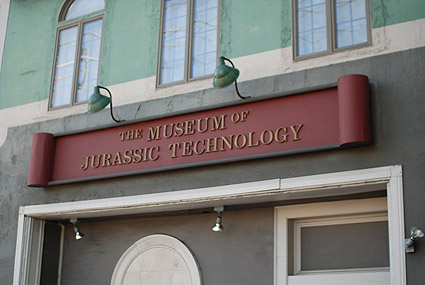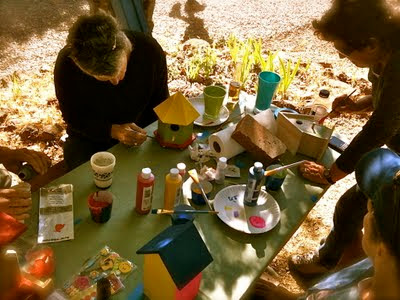CONTRIBUTIONS FROM
THE MUSEUM OF JURASSIC TECHNOLOGY:
I first came across the name of this extraordinary place when my friend Mitzi Pratt (NYC socialite) asked me to be meet her in what she called one of her favorite places in Los Angeles, The Museum of Jurassic Technology. After locating it in Culver City, I begin to understand why she likes it here so much. The exhibits in the museum cross the line between fact and fiction, between reality and imagination.
Front of the museum in Culver City, Los Angeles
The collections of the museum, which was founded in 1989 and is being curated by David Hildebrand Wilson and Diana Wilson, span over three little buildings and consist of pieces from about a dozen sub-collections which are often centered around a certain subject such as belief and knowledge or personalities like Athanasius Kircher and their work. But, unlike what one might expect of a technology museum, throughout all of the exhibits, the boundaries between history and fiction, magic and reason, narrative and scientific method are in fact completely fluid (and the curators pleasurably make no effort to make things more clear, even indulge in elaborate descriptions and allusions that make it even more mysterious).
Many of the pieces consist of wonderfully crafted models and often amazing analog visual tricks for superimposing images. As a result, the whole space turns into a magical wunderkammer like I've rarely seen it, and probably one of the most astonishing approaches to the culture of art and technology on the planet.
The reason I mention this museum here is because of the outstanding exhibition I once saw there (which is part of the permanent collection) entitled, GARDEN OF EDEN ON WHEELS. This is a collection of model mobile homes and travel trailers which glow and flicker in a darkened room, complete with sounds of a.m. radios and t.v.s playing from within and the distant sounds of crickets and campfires.
GARDEN OF EDEN ON WHEELS
Here is some of the text the accompanies the exhibit:
"The house trailer is, of course, but a sub-set of the larger age-old category of mobile dwelling. From the Basque sheepherder tent/coat and Bedouin woven goat hair "blacktent" to Mongolian yurts, human ingenuity has created an astonishing array of portable dwellings. However, in America, it was the migratory worker and seasonal factory worker, tacking together small masonite trailers or packing up their home built housecars and assembling in camps as early as 1920; or, the evangelist, carpenter or salesman, who built their first trailer to follow some private dream; or simply the old time "trailerite" or auto camper, a casual, cantankerous and fiercely independent soul of the teens and twenties who together caused a brand new industry, mobile home production, to emerge and flourish right out of the depths of the Great Depression."
















































